Go to All Blogs | Birding in Norfolk Blog | Our UK Office | Norfolk Birding Day Tours | UK Birding Tours
European Birding Tours | All our birding tours
Posted on 09 June 2021
Andy Walker offers some thoughts on the common garden birds of the UK in the first of three special blog posts on the common birds of the UK.
We find some amazing rare, scarce, and localized birds on our United Kingdom (UK) birdwatching tours, whether that be our UK: Ultimate Spring Tour (covering England and Scotland) or UK: England in Winter Tour set departures or our year-round UK: Norfolk Day Tours, with these high quality birds quite rightly featured highly in the tour itineraries and tour photo galleries.
However, there are loads of really fantastic common birds possible on these birding trips, that for an overseas visitor (particularly someone from outside Europe), will be pretty mind-blowing and probably also highly sought-after species, with the likes of European Robin, European Goldfinch, Eurasian Blue Tit, European Green Woodpecker, Northern Lapwing, and Tufted Duck often being much-desired species. However, due to these species being so common they often only get briefly mentioned. So, we figured we would showcase over 50 of the gorgeous common birds found in our UK birdwatching tours across three simple blog posts – it should be stated that many of these species are also very frequently found on most of our wider European bird tours too:
- Common garden birds (this blog post)
- Common farmland and woodland birds (the second blog post)
- Common wetland and coastal birds (the third blog post)
The focus of this blog post are the common garden birds in the UK. There is of course plenty of overlap between the birds in each of the three blog posts we’ve put together as most species do also occur in other habitats, however what is certain, all are easily found on our British birding tours (and many of our other European birdwatching tours when in range). Many of these species also give great photo opportunities too, especially when they are visiting garden bird feeders.
Please do enjoy the information and photos below featuring some of the commonest species found in the gardens of the UK.
European Goldfinch, Carduelis carduelis – This stunning species is very common and spends time in farmland and gardens across the UK. Numbers swell during the winter as birds move across to the UK from continental Europe. They can often be found in large post-breeding flocks and love visiting garden bird feeders (they are fond of sunflower and niger seeds). Their pretty and jangling call is a familiar sound, as is the sight of a flock of them bouncing across the sky.
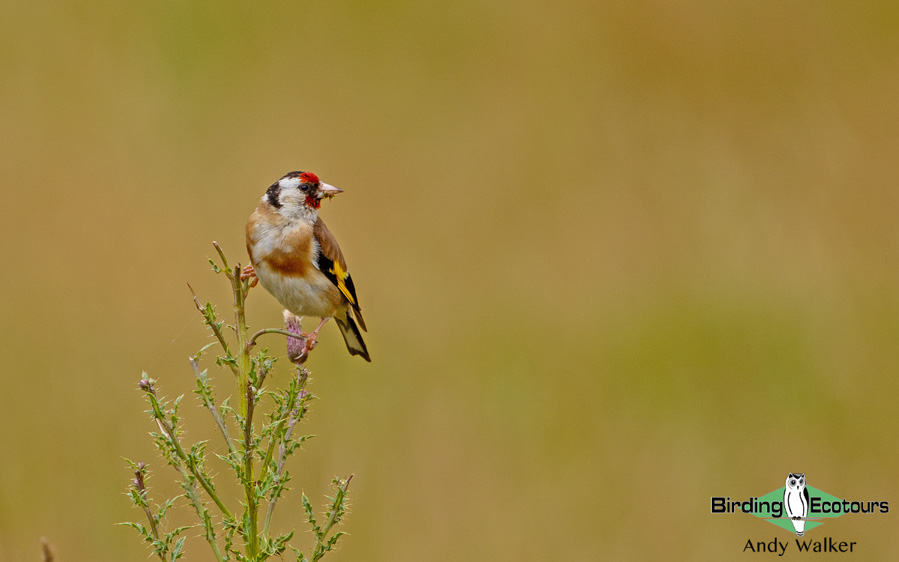
Common Chaffinch, Fringilla coelebs – An abundant species in woodland, parkland, and gardens. An extremely familiar and powerful call, it is often one of the easiest to pick out over the other calling birds and frequently heard on TV shows, especially period dramas filmed in wooded grounds. They will be resident in some gardens and winter visitors to others with huge numbers coming across from northern Europe in the fall. The east coast of England in the winter is great for finches.
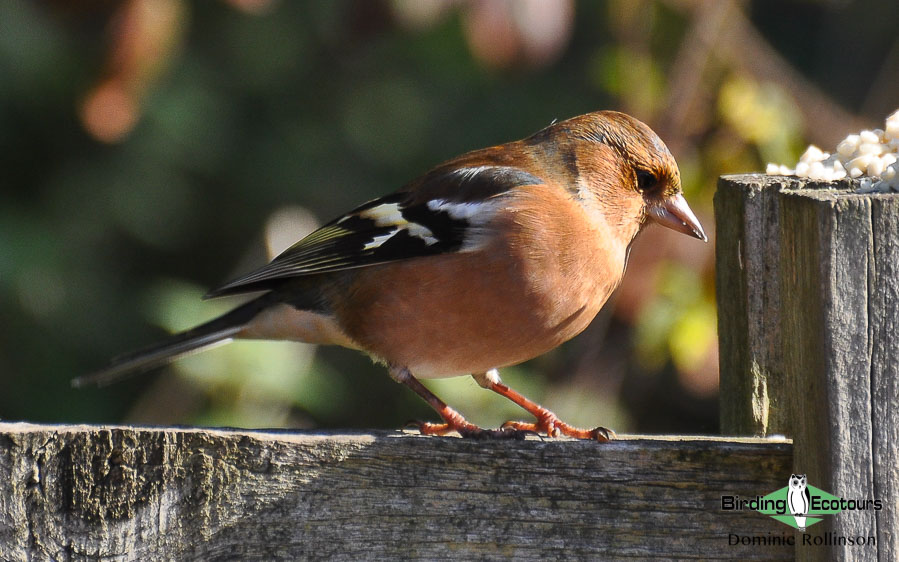
European Greenfinch, Chloris chloris – Actually a once-common species that is in a rather tragic decline at the moment, principally linked to the parasite Trichomonas gallinae which causes the disease Finch Trichomonas, that affects the upper digestive tract (BTO 2020). Historically, like the above two finches described, European Greenfinch was one of the most frequently observed garden visitors in the UK, however, it is much scarcer now, or even totally absent from some areas. A love of sunflower seeds has them returning to gardens where they will sit for hours devouring food.
Eurasian Blue Tit, Cyanistes caeruleus – Another particularly common and instantly recognizable garden bird. Small, at c.4-4.7 inches (c.10.5 – 12 centimeters), but extremely feisty – bird banders (ringers) love to hate them as they do like to bite, their bill is actually designed to eat insects and seeds. They readily take to nesting in bird boxes and are therefore one of the most frequently studied species by young birdwatchers as they get to grips with birds in their garden for the first time (such as was the case here). A fanatical visitor to garden bird feeders, here they are often the first to find stake a claim to new feeding stations. They can often become rather tame and so give great views most of the time. Their alarm calls are great for letting you know when a predator is around – such as Eurasian Sparrowhawk!
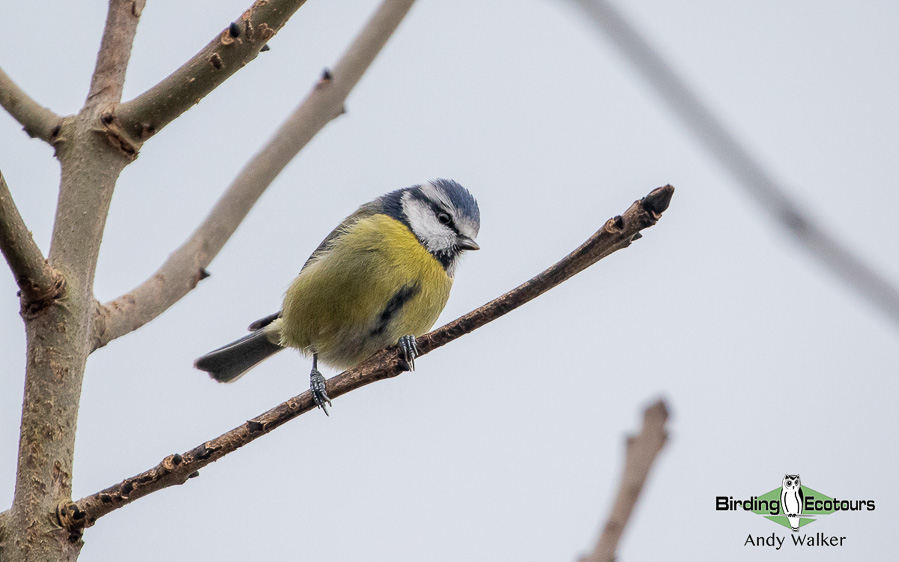
Great Tit, Parus major – Another abundant and well-studied garden tit. Larger than the above species, it is more dominant and readily stakes a claim to the best part of the garden/preferred foraging trees where it is often found much lower down, even frequently foraging on the ground. Another great bird to have as a lookout for predators with an extremely distinctive call.
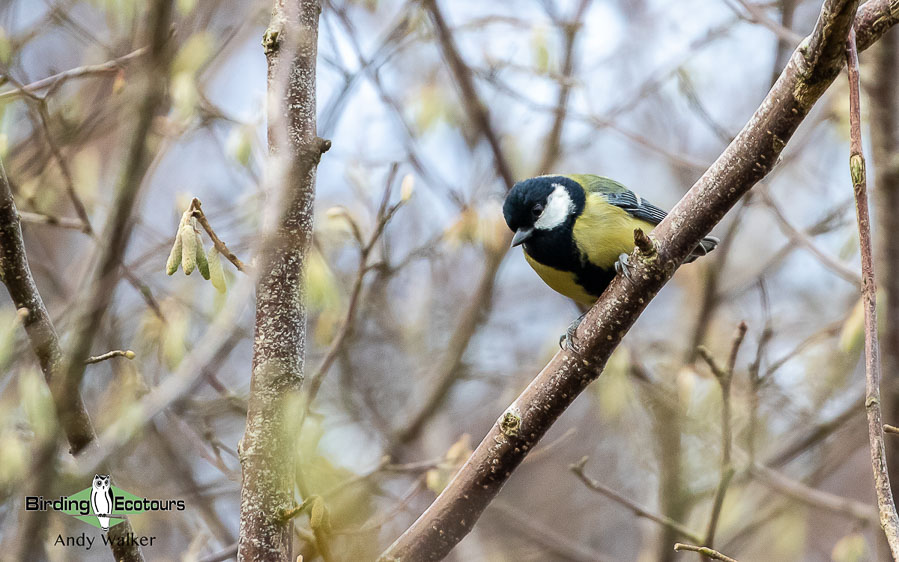
Long-tailed Tit, Aegithalos caudatus – Actually a bushtit rather than a true tit/chickadee. They can visit gardens year-round when the garden contains suitable habitat but are most frequently encountered during winter months when roving flocks (30 birds in a flock is not uncommon) move through gardens. They descend en-mass, often with other species before continuing on their way again.
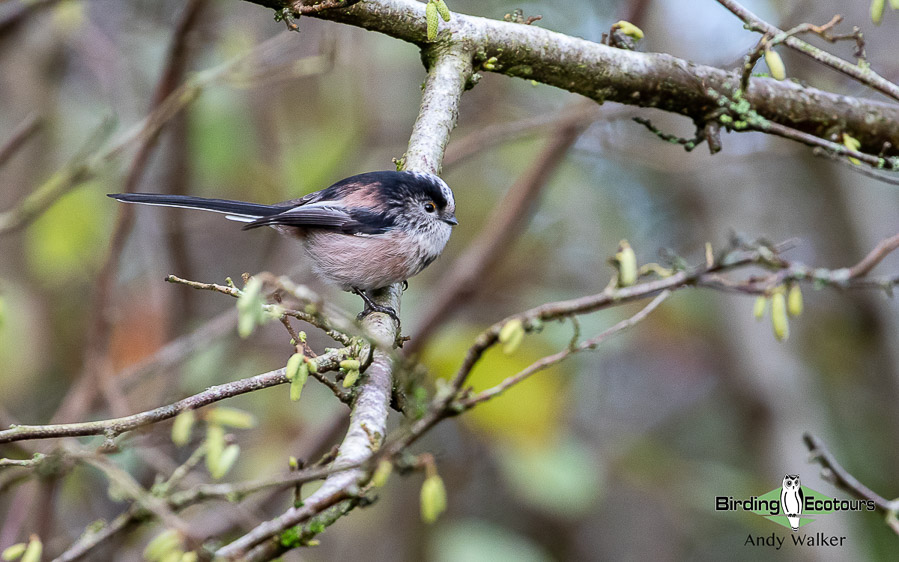
Great Spotted Woodpecker, Dendrocopos major – The commonest woodpecker in the UK, found across most of the country and a frequent garden visitor. A large pied species (much larger than the much rarer Lesser Spotted Woodpecker) that is very distinctive and is often heard before being seen, either drumming or with their well-known flight call. We will get great views of these during our spring and summer tours.
Common Wood Pigeon, Columba palumbus – One of the commonest birds in the UK now, and they breed almost year-round. During the winter massive flocks can be seen and they form huge roosts of many thousands of birds. Although probably overlooked by many British birders, as they are super abundant, to a foreign birdwatcher they are considered quite interesting, and are rather attractive in their own over-sized way!
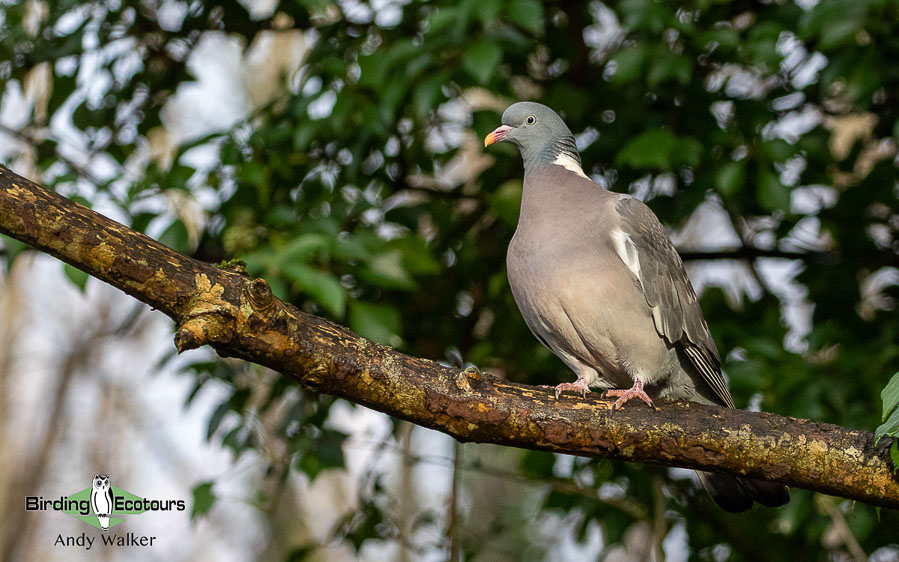
Song Thrush, Turdus philomelos (UK Red List: Birds of Conservation Concern 4) – Another garden bird that has declined massively in the UK and is now far scarcer than it was twenty or thirty years ago. This species has a truly breathtaking song that can be given all day and all night in the breeding season, often from the top of a tree. They are often one of the earliest passerines to start singing and are considered one of the true indicators of the onset of spring. They spend a lot of time foraging on the ground where they hunt for snails and worms. Their presence can often be given away by the crashing sound of a snail shell being banged against an anvil stone. Numbers of this species swell in the winter when birds living in the countryside move into gardens and birds from continental Europe fly to the UK for the milder winter when they become easier to see.
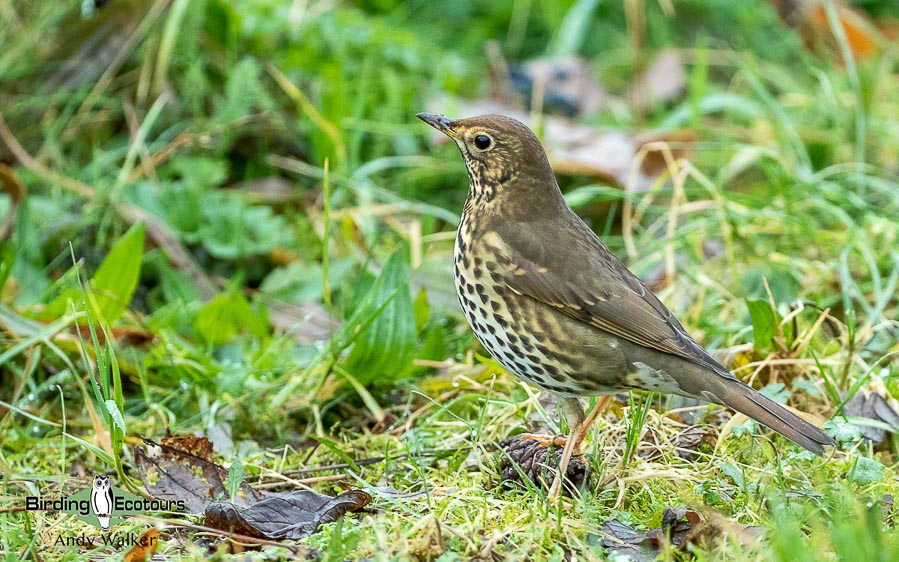
Common Blackbird, Turdus merula – Like the above species, a bird with a beautiful and famous song (think The Beetles and others!). Probably found in almost all gardens across the country, the male (black) and female (brown) are an extremely familiar sight. They are extremely territorial and “chases” between birds across gardens are frequent! As with several of the species mentioned here, numbers swell during the winter with continental birds joining resident birds. It is not infrequent to get flocks of them visiting gardens and at these times they do tend to tolerate each other a little.

European Robin, Erithacus rubecula – Instantly recognisable, this small and friendly bird (unless you are another robin) is a frequent companion to anyone tending their garden, as they follow the gardener for any worms that might have been disturbed in the soil. With a delightful song they entertain garden birdwatchers across the country, they are also probably one of the prettiest birds in the UK and always popular with overseas visitors, it is easy to see why.
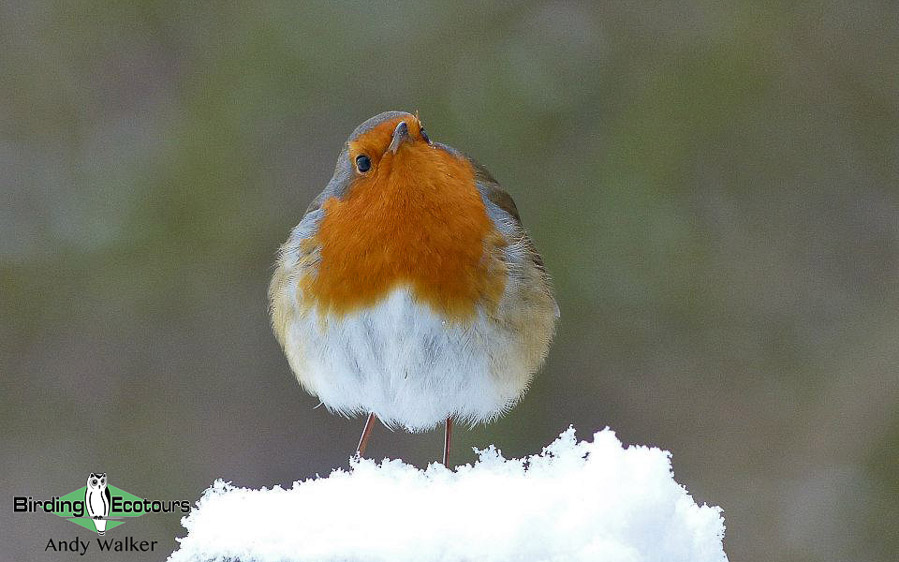
Dunnock, Prunella modularis (UK Amber List: Birds of Conservation Concern 4) – A common and subtly beautiful garden resident across most of the UK. More often heard than seen as they are rather shy but with a powerful and attractive song. They spend a lot of time low down foraging for insects on the ground, often below hedges, in fact they have historically been called Hedge Sparrows due to their passing resemblance to House Sparrows (though they are not sparrows at all, they are actually accentors, a primarily Asian family). This LBJ (“little brown job”) has a lot more going on than you might imagine, they have a rather interesting sex life…
Eurasian Wren, Troglodytes troglodytes – Has an unmistakable silhouette with an almost-always cocked short tail and has an ear-splittingly loud song, often given from exposed song perches. A very familiar and much-loved garden resident but also present in a huge number of other habitats and one of, if not the commonest birds in the UK. They look like a small mouse as they move around on the ground and through bushes! An interesting fact, the species is also known colloquially as “Jenny Wren”, a name believed to have come about in the middle ages. Another interesting fact, Paul McCartney (of The Beetles fame) has written a song called “Jenny Wren” about a character of the same name from Charles Dickens’ 1864 and final novel before his death, ‘Our Mutual Friend’, and the wren is also reported to be his favorite bird!
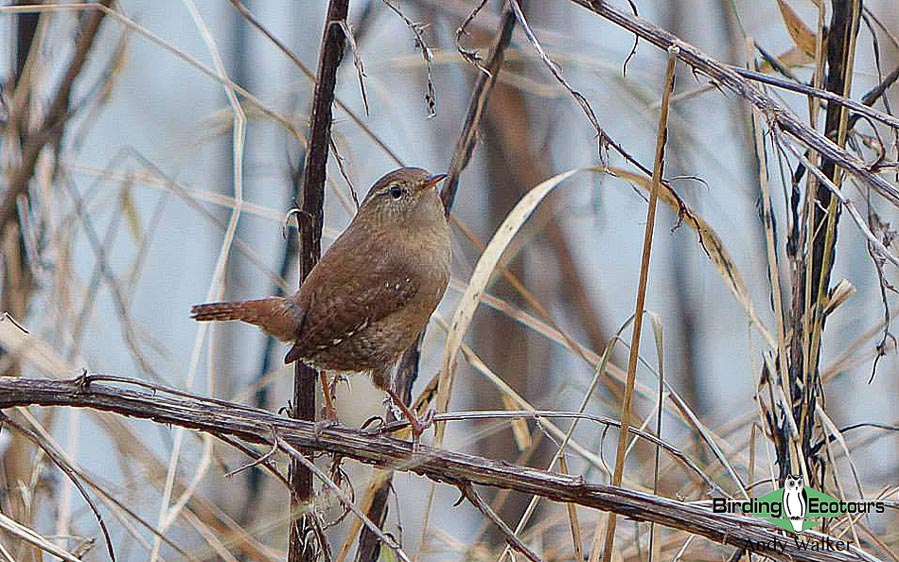
White (Pied) Wagtail, Motacilla alba yarrellii – The British sub-species of the White Wagtail species complex often known as “Pied Wagtail”. Is often more commonly found in urban gardens than suburban ones but is also found in a range of other habitats including those far away from human habitation. During the winter large flocks of this species gather together in communal roosts, often in supermarket parking lots (car parks) or town/city centers.
Eurasian Magpie, Pica pica – Is one of several very familiar corvid species in the UK, others being Carrion Crow, Western Jackdaw, and Rook. All four of these species can be seen in gardens and parks in towns and cities without any trouble. Other species such as Hooded Crow, Red-billed Chough, and Northern Raven have a much more restricted range in different parts of the UK. Most of these corvids are various tones of black and grey so the Eurasian Magpie is rather unique in color and in having such a long tail. They are highly gregarious birds and move around in flocks terrorizing smaller species which they often predate (especially when they are nesting). Their harsh call is a common and instantly recognizable sound.
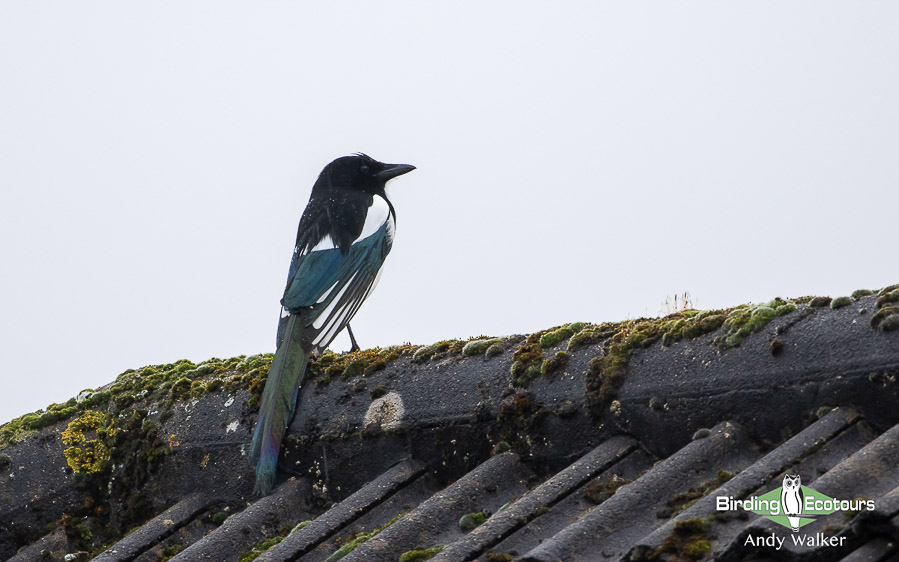
There are plenty of other very common garden birds that we have not featured here as they are common and well known worldwide, such as House Sparrow, Eurasian Tree Sparrow (a common garden bird in some areas of the UK but rare in many others), Eurasian Collared Dove, and Common Starling, though all of these four species have undergone massive population declines in the UK and all except for the dove are now on the UK Red List as Birds of Conservation Concern.
Many of the above birds can be attracted into gardens quite easily with the right equipment (feeders/nest boxes etc.) and a plentiful supply of suitable food and water, along with considered planting to attract nature on your doorstep (there is some excellent advice and ideas here from the Royal Society for the Protection of Birds – RSPB). There are several easy ways you can contribute to citizen science projects from your garden too, such as the following BTO projects: Garden Bird Feeding Survey, Garden BirdWatch, Gardenwatch, and Garden Wildlife Health, the RSPB’s Big Garden Birdwatch, and various eBird projects, all are of great value, fun, and educational and are a great way to develop your birding.
If you are actually in the United Kingdom, we recommend looking at the One Stop Nature Shop, otherwise, they have a fantastic online store. Or, as they are located in Burnham Deepdale (Norfolk), why not combine one of our Norfolk day tours with a visit to the shop, which is also great for looking at a range of optics if you are in the market for some quality equipment.
Click for Common Farmland and Woodland Birds of the UK
Click for Common Wetland and Coastal Birds of the UK
